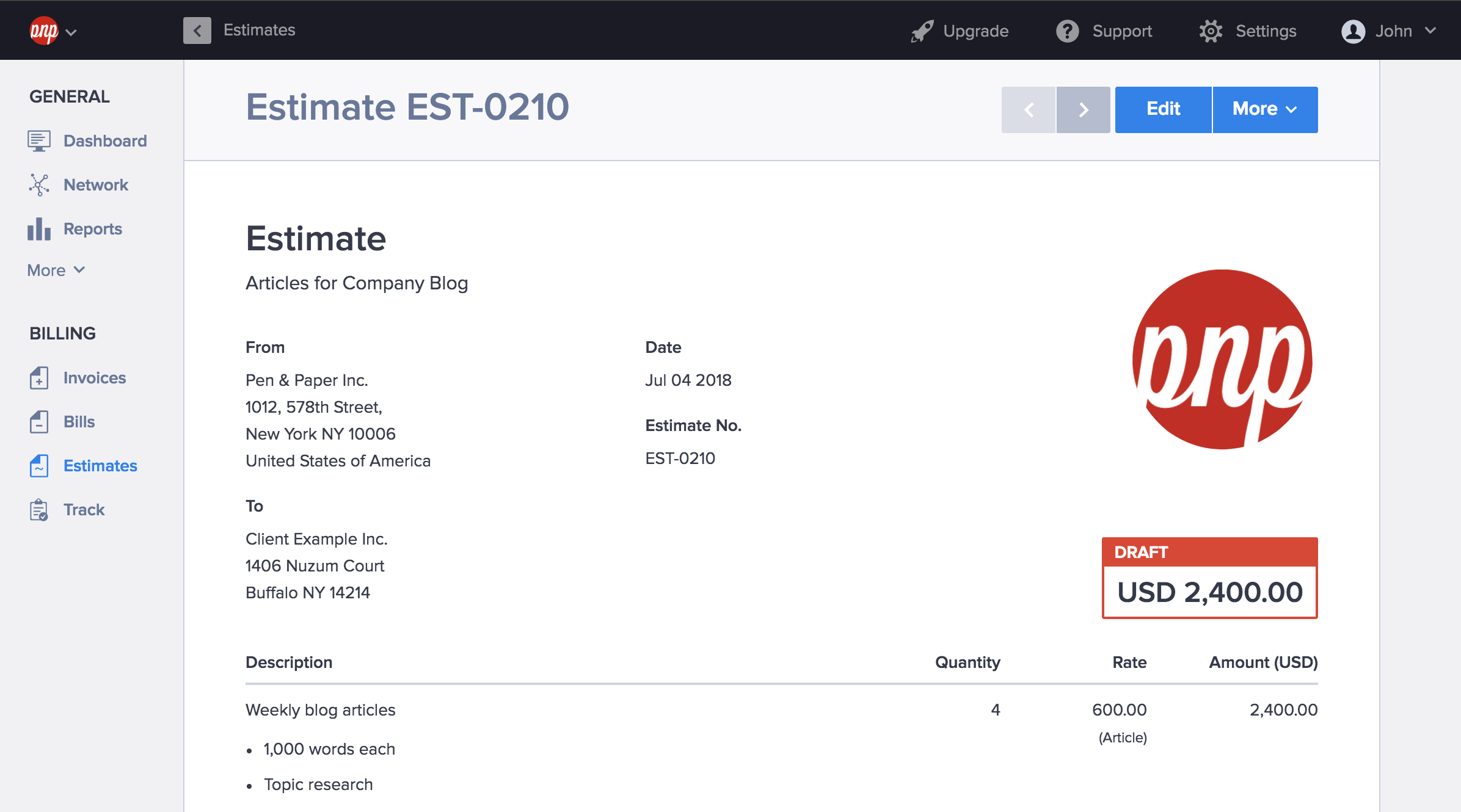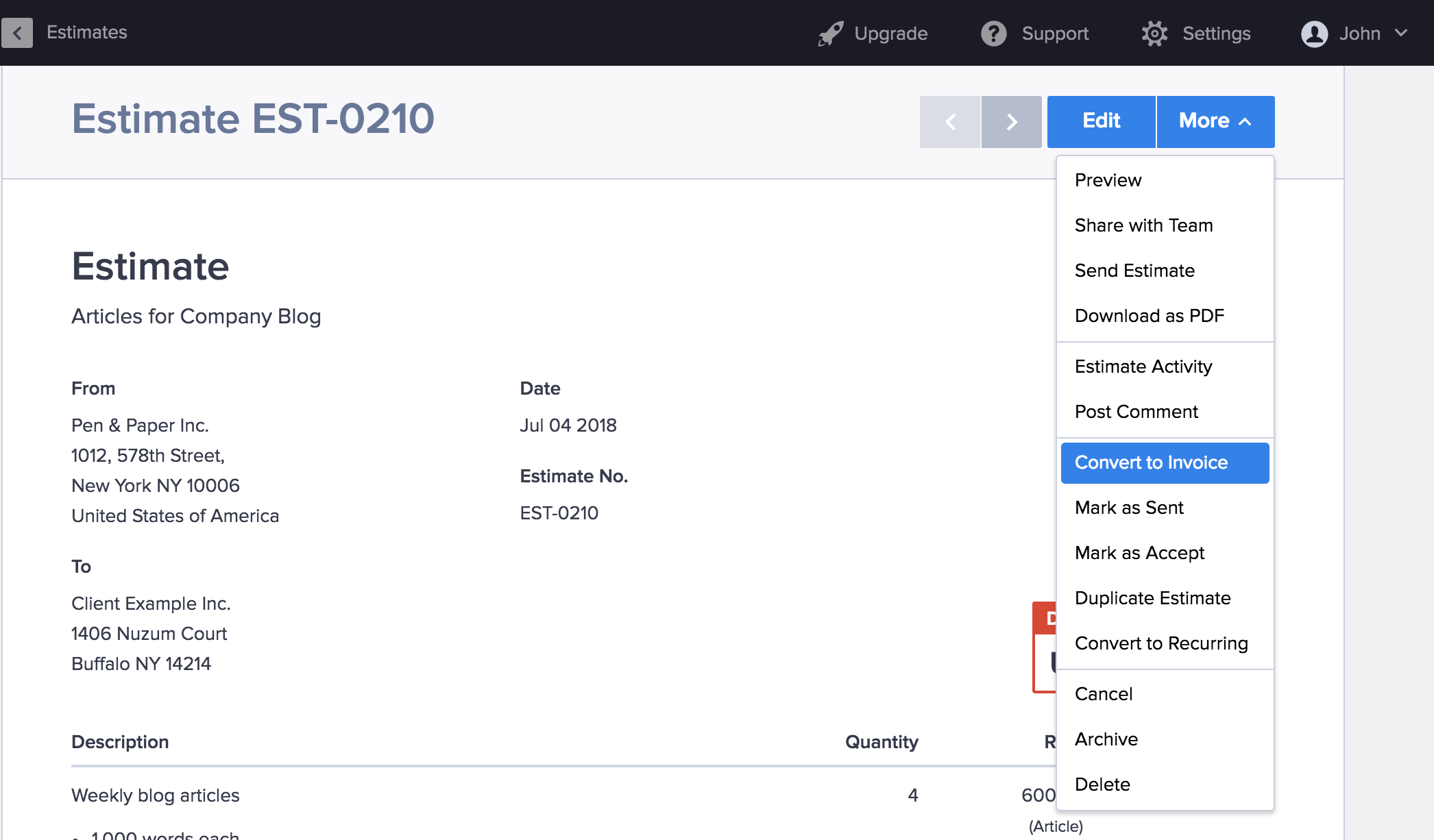How to Give an Estimate as a Freelance Writer
When you’re just getting started as a freelance writer, it can be difficult to know what to charge for your services. It can be even more challenging to create and send an estimate if you’re inexperienced.
However, there’s no ‘dark art’ to setting estimates. By being thorough with your itemization, and employing a healthy dose of logic and foresight, you’ll be able to accurately predict the cost of a job.
A better way to manage your finances
With Hiveage you can send elegant invoices to your customers, accept online payments, and manage your team — all in one place.
In this guide, we’ll show you how to give an estimate as a freelancer, and how you can create and send one online. We’ll also look at how you can save time by turning your estimate into an invoice. Let’s get started!
A Brief Look at Estimating Your Work as a Freelance Writer
You may be familiar with the general concept of project estimates, but let’s give you a solid definition. In short, an estimate is essentially a price breakdown of the work you’ll carry out for a client. While this can be quite a rough measure, the client will usually prefer a more accurate estimation.
Providing an estimate or quote for the work you’ll carry out for a client is an important milestone in your working relationship. Your own experiences of receiving a quote may have seemed off the cuff or picked out of the air, but there’s usually a lot of work involved in determining the estimate.
There are two major reasons a client will want an estimate from you:
- To budget ahead for the work you’ll carry out.
- To weigh up the service you’re offering compared to the competition.
Given the above, it’s clearly a crucial aspect to get right, considering you may have not yet won the work you’re estimating for. We’ll get on to how to actually give an estimate as a freelance writer next, but ultimately, you shouldn’t ‘undercook’ your pricing in order to simply win work.
What’s more, some clients will also want to use the breakdown as a pseudo-itinerary of the job, in order to judge the scope and timeline. If this is the case, it makes the step much more vital to ensure a smooth-running project.
How to Give an Estimate as a Freelance Writer
As we mentioned earlier, setting an estimate as a freelance writer is not picking a random number and presenting it to the client. There’s plenty you should be thinking about before you even get to the discussion with the client, such as:
- Will you charge by the project, day, hour, or word?
- Should you request a ‘retainer’ fee?
- Will ‘kill’ fees be a factor in your estimate?
These are just a few questions, although the answers you give will depend on the client in question. For instance, if it’s a new client where you have no prior relationship, you may want to estimate for advance payments and kill fees. Consequently, a long-standing client you trust could receive a single project quote, as they know you’ll deliver the goods.
However, for the majority of clients, your estimation will fall somewhere in between. How you get to that figure, though, means getting more information from the client during your onboarding phase. For example:
- How long will the project be?
- What’s the deadline for the project?
- Will the client provide an outline or other detailed brief to work from?
- Are images required – more specifically, do you need to carry out design work?
The key takeaway here is to ask as many questions as required to ascertain exactly what the project will entail. Once you’ve done that, you can safely estimate the time commitment. While this is a subjective element based on how you work, you’ll essentially need to apportion time to every task, no matter how big or small.
Factoring in Revisions, and Your Next Steps
Remember to also factor in any revision work you’ll undertake, as this could dilute your potential earnings and hourly rate. Also clarifying a cut-off point for amending your estimate is a solid idea, as ‘mission creep’ could see you in a never-ending cycle of revising your costs.
Finally, you’ll want to use the information you have to work out a minimum rate, which involves working out your ‘salary’ for the job, then calculating your billable hours. Dividing one by the other gives you the rate for the work, which will help you develop your estimate in relation to the type of billing you settled on earlier.
Using Hiveage to Create Client Estimates
While the process of creating estimates is a potentially complex task that could affect whether you win work, actually creating your estimates should be a piece of cake. However, many often falter here, mainly because their chosen solution can’t deliver the goods.
For example, you could simply email the request across, although this could get lost as the project progresses. A spreadsheet is likely a better option, but there’s a potential timesink here as you’ll need to format the document correctly, and also make sure your formulas are accurate. If you have the time, inclination, and expertise, using a spreadsheet is likely the most flexible solution available.
However, we’d argue that there’s more to an estimate than simply providing a documented cost. There’s also the correspondence and scheduling that goes along with it. Given this, a solution such as Hiveage makes complete sense for offering an estimate as a freelance writer:
You’re able to work with flexible customization options for styling your estimates, and formulas are calculated automatically – including any applicable taxes. What’s more, you can set specific branding elements, to make sure estimate you send are consistent regardless of the client or job. Furthermore, you can include your terms and conditions in the Estimates Notes field.
In addition, there’s much more power under the hood that a spreadsheet or simple email can’t offer. For example, while you can send estimates via email directly from within Hiveage, you can also set expiry dates and automatically inform clients of upcoming deadlines. You can also duplicate estimates if you wish, and generate them on a recurring schedule for those clients with regular, similar projects.
Turning Your Estimate Into an Invoice
Of course, once you’ve had your estimate approved and begun a project, you’ll need to invoice your clients. This is a snap within Hiveage, as you can find a Convert to Invoice link within the More menu of any estimate:
Once you click it, you can circumvent the usual steps and generate a full-fledged, ready-to-send invoice for your client. Of course, you get all of the usual functionality, such as invoice tracking, tax and shipping calculations, and automated receipts and payment reminders. Overall, this makes Hiveage a superb solution for freelance writers who need a flexible and powerful invoicing solution.
Conclusion
Providing an estimate as a freelancer has repercussions if you get it wrong. While the pre-estimate process is no joke, bringing up money makes the client relationship a serious proposition. As such, your estimation process requires thought.
In this post, we’ve talked about how to give an estimate as a freelance writer. Rather than just winging it and crossing your fingers, we recommend putting some trust into a dedicated invoicing platform such as Hiveage. Using the solution is a breeze for creating and sending estimates online, then turning them into full invoices ready to be issued to clients.
Do you have any questions about how to give an estimate as a freelance writer? Let us know in the comments section below!
Join thousands of business-savvy entrepreneurs on our mailing list.
Curated emails that’ll help you manage your finances better.




